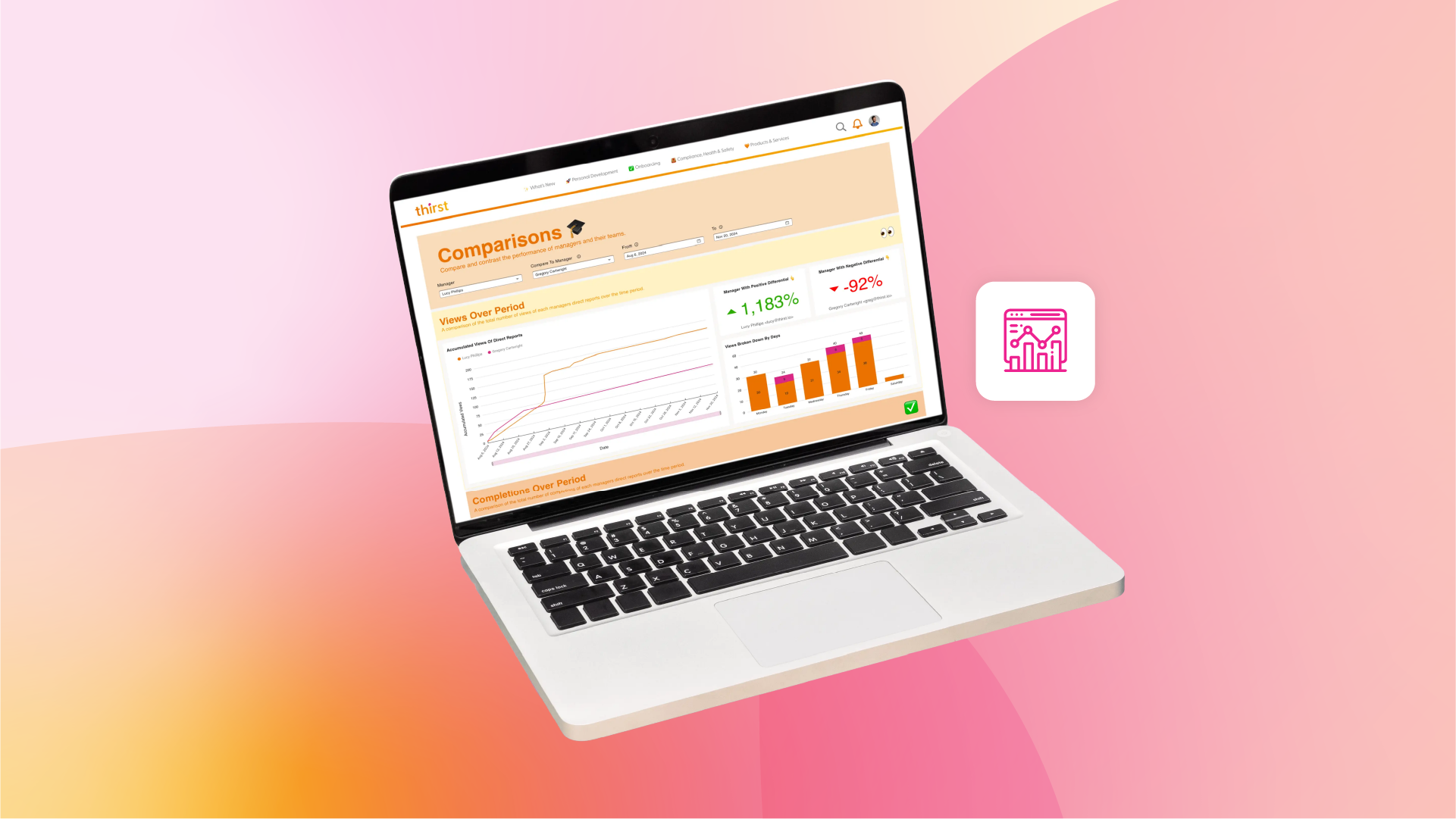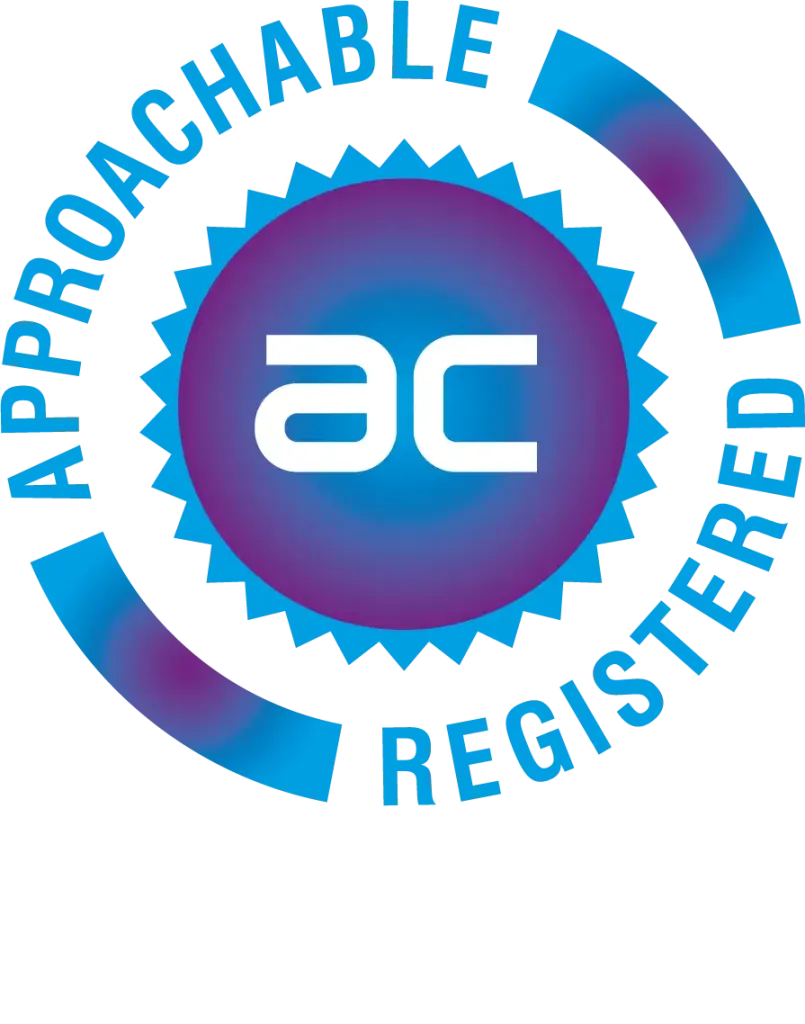As learning management systems (LMSs) continue to evolve, they’re becoming more essential than ever for organisations of all shapes and sizes.
The widespread adoption of LMSs is transforming industries across the board, dramatically improving how learning and development happen. But only if they’re used effectively. And that’s where measuring and improving performance comes in.
Imagine you’re looking to upskill your workforce – maybe there’s been a change in regulation that your employees need to understand.
Take 2025, for example. New legislation around mental health has been introduced. Under the Equality Act 2010, employers are now expected to create a culture that puts mental well-being on par with physical health.
So, what does that mean for your organisation?
For many, it means investing in training that helps employees understand mental health in the workplace. But creating content isn’t enough…you need to know it’s working.
By using LMS metrics and KPIs, organisations can assess how employees engage with training, understand what’s landing (and what’s not), and identify ways to improve future learning experiences.
In this blog, we’ll take a deep dive into LMS metrics – what they are, why they matter, how to use them to improve outcomes, and which common mistakes to avoid.
Sound good? Let’s dive in.👇
What Exactly Are LMS Matrices and KPIs?
LMS matrices and KPIs both help you track and measure performance, but they do slightly different things.
LMS matrices are tools that help you map out and compare different areas of learning performance.
KPIs (Key Performance Indicators) are the specific numbers or data points you use to measure how well something is working.
Let’s break that down simply:
LMS matrices:
- Visualise and analyse performance, this can be anything, from people to products
- Assign performance levels, e.g. by scoring levels out of ten
- Support decision-making, e.g. help identify training needs or resource allocation
KPIs (or key performance indicators) are quantifiable metrics used to measure how effectively an individual or organisation is achieving its objectives.
KPIs:
- Track progress toward strategic goals, e.g. strategic goal: increase customer base, KPI: increase customer base by ‘X’ percentage each month
- Measure success against predefined targets, e.g. measure customer satisfaction, KPI: increase CSAT (customer satisfaction score) by 5% by the end of the quarter
- Highlight areas for strategic improvement, e.g. improve customer retention, KPI: increase customer retention percentage by ‘X’ amount by year’s end
In terms of an LMS, performance matrices and their KPIs might include course attendance, learner engagement, completion rates, satisfaction rates, post-L&D performance, and more. Organisations that measure these matrices and KPIs gain deep success insights. 📈
Why Measuring LMS Performance Matters
Simply deploying an LMS is not enough.
A bold statement, but one that’s not without grounds.
Measuring LMS performance matters. After all, without this, how else can organisations understand if their investment in L&D has been successful?
Any LMS metrics and KPIs (as we’ve already outlined) can be tailored to specific organisational short-and long-term goals. In short, measuring LMS performance matters. And we’ve listed the key reasons why below.
Measuring Performance Evaluates Learning Effectiveness
An LMS should execute, simplify, and expedite meaningful learning.
By measuring key outcomes, such as course completion rates, assessment scores, learner progress, and more, organisations can evaluate learning effectiveness.
For instance, if certain modules consistently show poor results, it may indicate that learner content may need to be revised, instructional deployment pivoted to meet learner needs, or additional learner support, such as tools like live chats and discussion forums, personalised feedback, or supplementary learning, may be required.
Measuring Performance Enhances User Experiences
Positive user experiences are critical to learner engagement and retention.
Organisations that monitor and report user interaction data, such as login frequency and time spent on tasks, can significantly improve productivity while gaining essential data to create KPIs. Ultimately, creating a profitable user experience.
Gathering this data promptly allows organisations to address any productivity or workflow snags, optimising engagement and creating a more intuitive and satisfying learning experience for everyone. And best of all, data can be used to iterate and improve existing processes.
Measuring Performance Gathers Insights in System Reliability and Efficiency
Technical performance is just as important as L&D content. After all, if users cannot easily access the data they need to improve their understanding, how are they ever going to improve their skillsets?
Metrics such as load times, navigation ease and permission accessibility help organisations to understand if their LMS is responsive, running smoothly, user-friendly and available to everyone.
Poor system performance can compromise user trust in the platform, disrupt learning continuity, and, ultimately, prove to be an ineffective LMS platform.
Measuring Performance Aligns Training with Organisational Goals
Measuring LMS performance helps organisations to ensure that learning initiatives support strategic objectives.
Data, such as tracking the number of employees that complete compliance training or acquire certifications, shows whether L&D is effective by meeting workforce goals or regulatory requirements.
This data makes it simpler for decision makers to make informed decisions, demonstrating L&D success, while providing insights into how any future L&D can be tailored to meet the needs of the organisation.
12 Key LMS KPIs and Metrics to Track
As you can see, using LMS metrics and KPIs to track, measure and improve your L&D is a game-changer. But only if you use the right metrics.
Below is a list of the core LMS KPIs and metrics that you should be using to make sure that you’re using the right data to optimise your L&D.
1. Course Completion Rate
You’d hope that every employee who undertakes an L&D course will complete (and ideally pass it!), but that isn’t always the case.
This is why the course completion date metric is paramount to identifying users who are actively engaged with–and benefitting from–your L&D courses.
Any data that sheds light on the percentage of course registrations versus course completions will give L&D teams insight into whether the courses they offer are meeting the needs of people and the organisation. A high course completion date indicates that learners feel engaged with the material. Poor course completion data indicates the opposite.
Once you’ve gathered the necessary course completion rate data, you can then begin to form a strategy to improve future L&D.
This could include streamlining course design, such as bite-sized learning, setting clear expectations and goals, including clear deadlines and outcomes, providing clearer motivation and recognition, such as progress points or awards, adding LMS elements, such as interactive assessments, like quizzes or polls to reinforce learning, and more.
2. Learner Engagement
As you can probably guess, learner engagement is one of the most critical metrics for measuring LMS performance.
Data such as login frequency, time spent engaging with L&D material and content interaction reveals how actively and meaningfully users are interacting with your L&D content.
High engagement typically correlates with better knowledge retention, higher completion rates and stronger learner satisfaction.
Learner engagement statistics inform LMS improvement in several ways. From identifying what works and what doesn’t to revealing which learners need additional support to recognising effectual and ineffectual content and supporting strategic alignment and ROI, statistics help organisations to make decisions that support decision-making when designing new metrics and KPIs.
3. Assessment Scores
Another key LMS metric that all sound organisations must leverage is assessment scores.
Why? Well, they provide measurable evidence of whether learning objectives are being met.
These scores go beyond tracking attendance or content completion; they reflect how well learners are understanding, retaining, and applying the information delivered through the LMS.
Assessment scores directly indicate whether L&D course content is successful in delivering the knowledge and skills employees need to prosper, something that benefits them and the organisation.
4. Drop-off Points
Let’s face it, not every L&D course is going to have a 100% attendance rate from start to finish.
Knowing the exact stage organisations lose learner engagement is vital. Why? Well, identify the drop-off point(s) and you have a clear idea of what aspects of the course content you should improve on.
This enhances the overall user experience and reduces any potential revenue losses, giving organisations clear insights into an LMS’s ROI. 🤔
5. Time to Completion
Tracking time to completion using KPIs and metrics is essential to gaining measurable insights into how long tasks, processes, or customer interactions take to complete. This data is crucial for improving efficiency, user experience, and overall performance.
But there’s more…
Time to completion KPIs and metrics are important. Why? They inform benchmarking and goal setting, creating baseline performance standards.
For example, opening a task, let’s say, answering a customer’s short online query, should take no longer than 15 minutes. Attaching a KPI to the task, say, closing ten such queries in a morning, allows organisations to effectively monitor performance.
Not only does a time to completion metric support continuous improvement, but it can also improve resource allocation and directly reduce recruitment costs.
6. User Satisfaction Surveys/NPS
Organisations that invest in gathering user feedback through user satisfaction surveys and NPSs (Net Promoter Scores) have access to strong data that demonstrates not only which aspects of an LMS users are satisfied with but, actionable data to make improvements.
Surveys can be distributed through various online channels, like email, website, or in-app, with metrics and KPIs measured in a way that individual organisations favour. NPSs, for instance, measure customer loyalty and likelihood of recommending the platform. CSATs, on the other hand, measure how satisfied users are with a specific product or service.
Remember to distribute your user satisfaction surveys or NPSs in a way to get the best possible feedback, i.e. if learners seldom communicate over email, favouring an in-app messenger service, distributing user satisfaction surveys or NPSs over email doesn’t make much sense.
7. Content Effectiveness
Tracking content effectiveness using KPIs and metrics allows organisations to understand how well their content meets strategic learning goals. Without measurement, content efforts can become a time-consuming guesswork exercise rather than a data-driven growth engine.
Conversely, once organisations understand what content works and what doesn’t, they can then adapt future L&D to meet organisational goals. To gauge content effectiveness, organisations can examine completion rates and get user feedback.
8. Learning Pathway Progression
If you want to effectively measure engagement and motivation, gain insights into learning effectiveness, monitor where learners are most engaged and where they drop off, and even uncover how high-level KPIs, such as course completion dates and learner satisfaction, are faring, you need to utilise learning pathway progression.
This key metric reflects how learners are engaging with, advancing through, and completing structured learning programs. So, therefore, it’s essential to monitor how effective your L&D really is! 🙌
9. Certification of Achievement
This one’s self-explanatory. The certificate is a quantifiable indicator of learners’ abilities once they have completed any L&D courses, meeting learning objectives.
But there’s more to it than that. Certificates function as motivators. Why? Well, it’s simple.
Learners are more likely to complete courses if they receive recognition at the end. Organisations similarly benefit from having certificates of achievement as they support commercial and compliance goals, being unmistakable evidence of professional development.
But, arguably, more importantly, certificates act as commercial metrics and can be tied to individual performance improvement, promotions, and career progression.
10. Active vs. Inactive Users
Active and inactive user statistics provide organisations with immediate, clear insight into which users are engaging with the L&D material. Active users, those regularly logging in, participating in courses, and completing modules, reflect how well the LMS is serving its purpose.
Inactive users, on the other hand, may indicate barriers to access, lack of motivation, or content that doesn’t resonate.
By tracking this ratio over time, organisations can easily identify learner disengagement trends and adjust strategies to improve adoption, such as offering refresher training, simplifying the user experience, or even promoting high-value courses.
Moreover, this metric supports data-driven decision-making about resource allocation and platform improvements.
If a sizeable percentage of users remain inactive, it may be a sign that onboarding is ineffective, or that communication around available learning opportunities is lacking. Conversely, a growing number of active users can validate recent platform upgrades or content changes.
11. Repeat Visits or Relearning
Organisations that leverage KPIs and metrics to track repeat visits or relearning gain vital insights that they can then leverage to adapt and evolve their L&D.
From improved knowledge retention through repeat visits and engagement with the L&D material, relearning key aspects – something that directly impacts the completion rate KPI – to improved knowledge retention and a reduced need for remedial learning, understanding repeat visits and relearning data is pivotal to L&D success organisation-wide.
12. ROI of the Training Program
As any organisation will tell you, training program ROI is a critical metric for measuring and improving an LMS because the metric links learning outcomes to business performance.
L&D costs money. And time. Organisations have budgets to work to. And managing time is crucial. Stakeholders will want clear, quantifiable evidence that their L&D investment is worth it.
By comparing the cost of delivering any training investment, such as using Thirst to deliver, monitor and measure L&D training, including identifying programs with the highest impact, LMS can better understand performance and adapt training, if needed.
Employees who actively engage with the LMS and reap the benefits of acquiring knowledge are more likely to be promoted. This suggests that the training is aligned with skill development and leadership readiness. This reinforces the value of the LMS as a tool for internal talent development and succession planning.
Higher employee retention among LMS users reflects stronger engagement, job satisfaction, and perceived value in the organisation’s investment in their growth.
How to Use LMS Metrics to Improve Learning Outcomes
There are several ways that organisations use LMS metrics to improve learning outcomes.
Now, of course, the value of individual metrics is entirely dependent on how an organisation wants to upskill its workforce, but knowing how to use LMS metrics gives organisations a solid foundation to maximise any KPI or metric impact.
LMS metrics improve learning outcomes by transforming raw data into actionable insights, which can be used to help organisations to refine L&D content, personalise learning and boost learner engagement.
Metrics can include course completion rates, personalised learning benefits, or something as simple as time spent on modules and quiz scores. This helps L&D teams to identify skills gaps and understand how learners are interacting with the content – creating a culture of continuous improvement.
There are several different metrics that organisations can adjust to better measure and improve their L&D ROI. These can include course completion rates, assessment scores and pass rates, learner time spent on modules and learner progression and pathways.
Moreover, using data to personalise the learning experience helps organisations to create a learning experience that’s tailored to individuals, therefore boosting the potential impact of any L&D.
7 Common LMS Data Mistakes to Avoid
Like almost any data mining exercise, there are several common data mistakes to avoid when using LMS metrics and KPIs to measure and improve performance.
We’ve outlined each of these below so you can be sure of what to avoid.
Tracking Vanity Metrics
Vanity metrics can inflate statistics, create a false sense of success, and neglect any meaningful insights into learning effectiveness or organisational impact. Metrics like total login count, page views, or even the total number of enrolled users do little to truly measure and improve an LMS.
Not Aligning KPIs with Organisational Goals
Failure to align KPIs with organisational goals can be problematic.
Why? Well, misalignment leads to disconnected or disadvantageous data. This means that organisations risk focusing on the wrong initiatives, such as improving the content of courses that don’t really benefit the organisational or overlooking critical knowledge and skills gaps.
Metrics like course completions or assessment scores may provide valuable insight, but does the data they uncover really align with KPIs with organisational goals?
Failing to Act on Data
Organisations that fail to act on LMS data face the issue of having insights that aren’t being used to drive meaningful change. Even if the right metrics are tracked, ignoring them results in missed opportunities to improve learning programs in ways that support organisational priorities.
Then there’s the problem that without action, KPIs remain static and disconnected from business outcomes like performance, productivity, or compliance. This compromises the value of your LMS, making it more difficult to demonstrate impact, leading to misalignment between learning efforts and strategic goals.
Lack of Regular Reviews
Not engaging in regular reviews of LMS metrics and KPIs can have a knock-on effect felt organisation-wide.
From identifying trends and pain points to making timely improvements, a lack of regular reviews can cause organisations to miss valuable insights.
Additionally, regular reviews ensure that LMS data remains relevant, accurate, and actionable, allowing organisations to adapt strategies, optimise content, and drive continuous improvement.
Tracking Too Many Metrics Without a Clear Purpose
Simply collecting data just because it’s available, neglecting to tie that data to strategic goals, can overwhelm L&D–and the wider organisation–teams. This makes it challenging for organisations to focus on what drives learning outcomes.
Ignoring Data Context and Benchmarks
Organisations that look for metrics in isolation, for instance, only focusing on course completion rates, without comparing that data to historical trends or benchmarks, are another mistake to avoid. Why? It makes it impossible to understand whether performance is improving or underperforming.
Failing to Act on Insights
The last mistake sounds obvious, but you’d be surprised how commonplace it is.
It’s all good and well for organisations to gain insights into LMS performance, but failing to act on them nullifies the value of the data, leaving performance gaps unaddressed.
Final Thoughts
When all’s said and done, effectively measuring your LMS performance is essential to optimising your L&D.
By focusing on meaningful metrics like learning pathway progression, course completion rates, assessment scores, learner satisfaction, and training ROI, organisations gain clear visibility into how learning contributes to growth, performance, and employee development.
Basically, if you want to ensure that your LMS is optimised to consistently have the kind of impact needed to promote organisation-wide change, using KPIs and metrics to measure and improve your L&D is not just advised, it’s essential!
Got 2 Minutes?
If your organisation is struggling with disengaged learners, Thirst has the solution. 🔥
Thirst is an AI-powered learning platform that helps L&D teams of all sizes boost learner engagement and create experiences tailored to today’s learners.
Take a guided tour today and see Thirst in action.
For more e-learning insights, resources and information, discover the Thirst blog.
You may also enjoy:
LMS Adoption Strategy: The Complete Playbook | What Is Informal Learning? A Complete Guide for L&D Teams | What Are Personal Learning Pathways? (And Why Your Learners Need Them)







